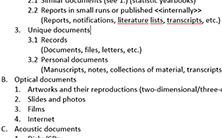Data collection and data analysis
Data collection
There are a lot of methods, methodologies, proceedings, approaches, etc. which will not be discussed here in more detail (cf. Atteslander (2006), Diekmann (2008), Flick (2005), Lamnek (2005), Reuber & Pfaffenbach (2005)). The most useful method to collect data when studying is the evaluation of all kinds of texts (see fig. 4) as well as the empirical collection of so-called primary data. Collecting texts in libraries or doing research online (e.g. in library catalogs, data bases, online journals, and other portals) is also considered as data collection. There are numerous data sources («documents», «material») from which to choose.
Example for data collections: «As regards tourism and school attendance, statistics already existing will be used.»
Other research findings already published in texts can also be used as data sources for further analysis. Here it is essential to apply formal criteria stringently (cf. «Writing an academic paper»). Without these criteria it is difficult to evaluate, for example, a research paper already existing before continuing to use it properly.
Data and data analysis
Data used for argumentation must be traceable as regards their origin since it is then possible to draw conclusions about the collection's circumstances or its primary purpose. It is also necessary to present any sources or acquisition methods clearly and precisely (e.g. author of quotation, circumstances of surveys, etc.).
Example: «Statistics will be checked for their plausibility; the number of tourists will be correlated with the one of school absences before checking these results for significance.»
We would like to point out that only listing data is not equal to producing results. Data require interpretation and are only of value after finding a relation between these data and the question posed during research or while writing a scientific paper.
Data without any analysis aren't results!
